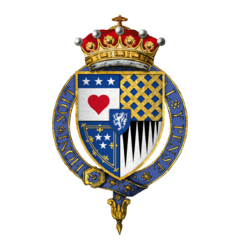James Douglas, 9th Earl of Douglas facts for kids
Quick facts for kids
James Douglas
|
|
|---|---|
| Earl of Douglas | |

Quartered arms of Sir James Douglas,
9th Earl of Douglas, KG |
|
| Predecessor | William Douglas, 8th Earl of Douglas |
| Successor | forfeit |
| Born | 1426 Scotland |
| Died | 1491 Lindores Abbey |
| Buried | Lindores Abbey |
| Noble family | Douglas |
| Spouse(s) | Margaret Douglas, Fair Maid of Galloway Anne Holland |
| Father | James Douglas, 7th Earl of Douglas |
| Mother | Beatrice Sinclair |
James Douglas, 9th Earl of Douglas (1426–1491) was an important Scottish nobleman. He was the last of the powerful 'Black' Douglas family leaders. He lived during a time of great change and conflict in Scotland.
Contents
James Douglas: A Powerful Scottish Noble
Early Life and Family
James Douglas was born in Scotland in 1426. His father was James Douglas, 7th Earl of Douglas, also known as James the Gross. His mother was Lady Beatrice Sinclair. James had a twin brother named Archibald Douglas, Earl of Moray. James was the older twin by just a few minutes.
Conflict with the King
James became the Earl of Douglas after his older brother, William Douglas, 8th Earl of Douglas, was killed. King James II of Scotland and his men were involved in his brother's death. James Douglas was very angry about this.
The First Rebellion
James and his brothers decided to fight back against the King. They attacked the town of Stirling. To show their anger, they rode a horse through the town. They tied the safe conduct pass, which had been given to William, to the horse's tail. This pass was supposed to keep William safe. However, some of James's friends left his side. This forced him to stop fighting the King for a while.
A Controversial Marriage
To keep the family's large estates together, James planned to marry his brother's widow, Margaret Douglas, Fair Maid of Galloway. He got special permission from the Pope for this marriage. It is not fully clear if they actually got married. James also began to make secret plans with the English royal family. In 1455, he rebelled against King James II once more.
Exile and Further Struggles
During this time, another part of the Douglas family became important. They were known as the 'Red' Douglases. George Douglas, 4th Earl of Angus, a Red Douglas, chose to support the King. He fought against James Douglas.
The Battle of Arkinholm
James Douglas's main allies left him again. He had to escape to England. His three younger brothers stayed to fight. They were Hugh Douglas, Earl of Ormonde, Archibald Douglas, Earl of Moray, and John Douglas, Lord of Balvenie. They were defeated at the Battle of Arkinholm. This battle took place near Langholm by the Esk River. Moray was killed in the battle. Ormonde was captured and later executed. Balvenie managed to escape to England. The last stronghold of the Black Douglases, Threave Castle in Galloway, was captured.
Life in England
In 1455, James Douglas lost all his titles and lands. This is called being attainted. His lands were given to his rivals. The main Douglas lordship went to the Red Douglas, the 4th Earl of Angus. From England, James Douglas continued to make plans against the new Scottish King, James III of Scotland. The English King, Edward IV of England, even hired James Douglas in 1461. His job was to arrange a deal with Scottish highlanders. The goal was to take the nine-year-old King's kingdom for England. At some point, James Douglas was made a Knight of the Garter. This was a very high honor. After losing his titles, his first wife divorced him (if they were married). He then married Anne Holland. She was the daughter of John Holland, 2nd Duke of Exeter.
Final Years
In 1484, James Douglas was captured at the battle of Lochmaben Fair. He was then sent to live at Lindores Abbey. He stayed there until he died in or after 1491.

